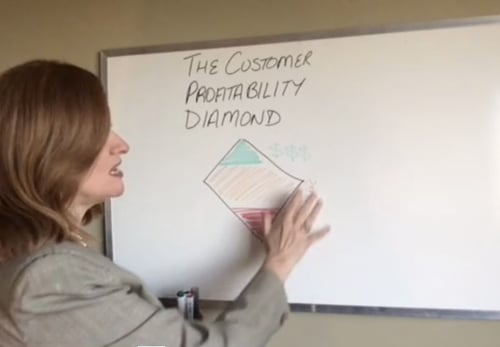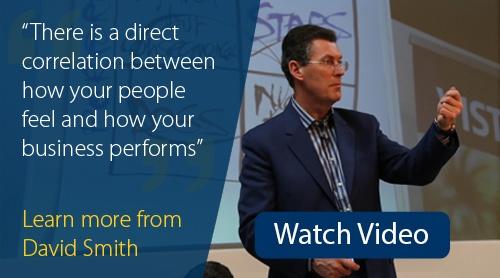
People are the only asset that walk out the door every night and consciously decide whether to return or not the next day. They decide each day whether to return in body only, or whether to show up fully engaged and productive. Scary stuff, considering how much you’ve invested in them! Lack of engagement is an increasingly epidemic challenge for business leaders at all levels, and the cost of an employee who’s simply going through the motions is one of the biggest hidden drains on profitability.
If you’ve been looking for strategies to create an engaged workforce beyond the usual teamwork, motivation, and perks/rewards approaches, you’re in the right place.
Trigger Employee Involvement with an AHA! Moment
The key lies in taking a new and unconventional approach to create employee involvement with your customers. The Customer Profitability Diamond is a tool that helps you quickly and easily engage your employees in determining who your most profitable customers are, who is costing them more than they’re worth, and who has potential to do more business with you. It’s surprisingly straightforward, because it’s not based on absolute rankings or in-depth accounting approaches, instead it's based on what your employees observe and experience every single day when they're dealing with you customers!
Here’s why it’s so effective. Can you name your Dream and Nightmare customers? Of course!
There are certain obvious behaviours and you just know them when you see them. This approach is not that simplistic, as a Dream customer can often be very unprofitable if you’re bending over backwards to take care of them, and Nightmare customers can be highly profitable if you price for the aggravation factor. However, your half-dozen or so drivers of profitability (and they’re different for every organisation) are just as observable. Within a couple of hours your team can assess your biggest customers using those profitability drivers and create a vivid picture ranking them based on 3 zones of profitability: the highly profitable, the marginally profitable and the unprofitable ones who are costing you more than they're worth. I’ve never yet seen an organisation fail to find that one of their biggest customers ends up in the unprofitable zone!
Case Study
You could have heard a pin drop at the boardroom table when a team of senior executives, account managers, customer service specialists, operations folks, and the accounts receivable clerks saw that their biggest, blue-chip customer had ended up in the unprofitable zone as a result of their combined input. The VP Sales who managed the account immediately started to bluster, claiming that was wrong, however as the team reviewed their rankings for each of the profitability drivers, example after example emerged to support their assessment. Then, the conversation changed. They automatically shifted gears and started brainstorming how to turn each of those situations around. In some cases, it was their own self-inflicted wounds – they were overservicing the account because they were nice people and because the VP Sales demanded the best. In some cases, it was the customer’s behaviours that needed to be tuned in, and they quickly developed an action plan. The entire team engaged in being part of the solution, and more importantly, took ownership for making it happen, simply by shifting smally everyday behaviours on their end, and by helping the customer to make small shifts at their end during every interaction. The result? Win-win for everyone, with a customer well-served, at great margins.
Turbocharge Employee Commitment
Actively engaging a cross-functional team of your employees in that discussion kicks off the process of engagement, because they can see where there are challenges at the customer end that they can have impact on. Late payment is one example (are customers who pay late less profitable than those who pay on time? Of course – you’re chasing them and financing them!). They’ll also see clearly where there are self-inflicted wounds within your company that can be dealt with quickly and easily, such as over-serving customers because after all, you’re nice folks who care about your customers! But it may be costing you a bundle.
The real magic and the way you turbocharge employee involvement and commitment is to transform your Customer Profitability Diamond data into what I call CPR for your business.
CPR is the Customer Profitability Ratio and the first time you work through this system, you’ll likely find that you have no more than 2-5 profitable customers for every one that’s costing you more than they’re worth… i.e. you’re working for free almost 1/3 of the time! Employees instinctively understand that 10:1, 50:1 or ever 100:1 is a lot better than 2:1, and they instantly want to be a part of that solution. Watch the video below to learn how to get your CPR ratio: which is (Highly profitable + Marginally Profitable Customers): Unprofitable Customers.
Success Story: Behaving like owners and driving bottom line results in just 30 days
Jessy is a 21 year old Accounting Clerk, fresh out of school. When she participated in the creative exercise of developing the Diamond and the CPR her world shifted, never to be the same. She realized that she had an important role to play in her fast-growing company by resolving the late payment issues. And she realized that because the strategy for unprofitable customers is to restore them to breakeven or better, not to fire them, she knew she needed to move past just sending out Past Due notices, and work more constructively with them. I share how she did it in the video, but the great takeaway is that within about 30 days, she had stepped up, taken action, and singlehandedly fixed the Receivables issues in a win-win way.
If lack of engagement and employee commitment is keeping you awake at night, it’s time to take an unconventional and highly engaging approach to increasing employee involvement, and creating an engaged workforce.
Take a quick look at the video above if you made it this far without doing so, share it with your team, and leave your comments here! I’d love to know the insights you take away from it, and how you’ll apply it to your own organisation.


